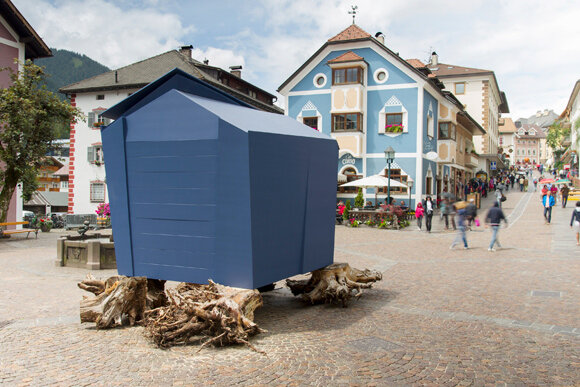
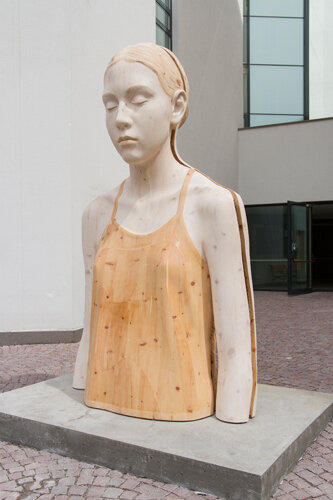
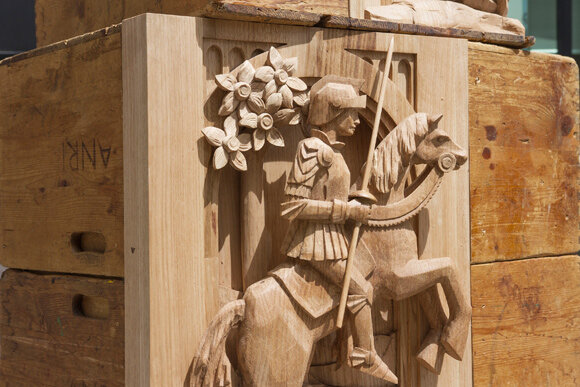
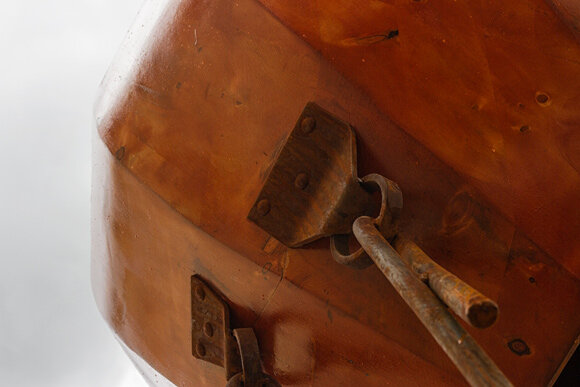
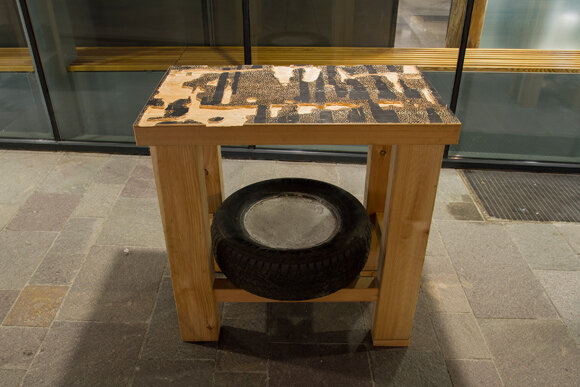
Concept
The expression "knock on wood" has to do with luck and with warding off evil; everyone feels the need to protect themselves from misfortune in some way. This sort of good mood surrounds the opening of the 4" Biennale in Ortisei and the Val Gardena, with its focus on contemporary sculpture. Five artists were invited to participate: two locals, Bruno Walpoth and Willy Verginer, who are however known around the world, and three artists from different places: Chris Gilmour is an English man who lives in Udine; Sonia Leimer was born in Merano but works in Vienna; and Velasco lives between Milan and Lake Como.
For the first time since the Biennale has been held, the artists were asked to create public sculptures that would interact with the historic town centre of Ortisei, dialoguing with residents and tourists rather than imposing themselves as if they had been dropped into town from outer space. There were no restrictions as to subject or theme, but the material used had to be wood, even though the artists were not all experienced in working with this material.
These are the three factors that give the project its poetic significance. The first was a need to stand out from all the exhibitions held all over the place, to do something that could only be done here, in the Val Gardena. Seeking a specific link with the land and the local cultural traditions does not mean fighting against globalisation: far from it. It means going back to roots that attract a lot more interest than a generic sort of product that might be found anywhere, and is just the same everywhere in the world. From this point of view, art could stand to learn some lessons in strategy from the world of food and wine: one of the few sectors of the market which is still going strong in Italy, where there is still more demand for traditional local dishes than for sushi or couscous! The second factor is the creation of five projects on such a large scale - we might call them monumental in scale, if only the term did not have such self-celebratory associations which brought together artists, craftspeople, workshops and small industries, in a virtuous short-circuit that has also had a major impact on the local economy. For today art does not take place solely in the artist's studio, but relies on a number of different professions, often highly skilled and sophisticated in terms of both manual skill and use of technology, all of which are essential to the creation of the finished work, after interpreting and making possible all the stages in the transition from idea to project and then to "object". While this of mentality has solid roots in conceptual art the Minimalists in particular emphasised the need to delegate the creation of the actual work of art to others, because the artist's task is essentially to come up with the concept the association is not automatic when working in other artistic styles and vocabularies. Some still think of the sculptor as being shut up in his workshop, surrounded by tools and dust, when in actual fact he is much more often an engineer who rationally organises the work and the workers. It's not a matter of preferring one attitude over another, but we might say that the combination of a strong design concept with equally strong manual skills constitutes the ideal balance. And finally, the third factor: wood is a very particular material which, like ceramic or glass, is more commonly associated with crafts than with art (at least, contemporary art). As it is not particularly high-tech, wood attracts us with its warmth, but this could also be seen as a limitation. It has therefore been removed from the hit parade of today's artistic vocabularies, even though it had been used in experimental ways by great sculptors of the past, at least until taste took a turn toward vintage, towards the powerful return of the past, the apotheosis of everything "handmade", the discovery that tradition is an added value rather than a limitation for a contemporary artwork. This does not apply only to the visual arts, but to music, fashion, architecture and design. We are all consenting victims of a hunger for the past, because the present is uncertain at best, and let's not even think about the future! In the field of fashion and design, in Retromania music critic Simon Reynolds notes that "the market for vintage clothing boomed, and this was paralleled by the 'antique-isation' of furniture and artefacts from the second half of the twentieth century, as the shelter magazines went nuts for mid-century modern furniture". Wood therefore brings its own added value with it, because of its incredible relationship with the past; it tells stories, it doesn't turn away the viewer, it incites with its warmth and texture. More and more artists all over the world are using wood as the material for their sculptures (while there were very few, other than Stephan Balkenhol, until only a few years ago) and in their installations. We might even call wood "trendy", if the term were not such an ambiguous one. The five sculptures, produced following presentation of plans by the artists, who have been working on them over the past few months, with regular visits to the Val Gardena, will be set up in the historic town centre of Ortisei in the summer of 2014. We interviewed the artists and asked them how their projects came about, from plans to final creation, and how they particularly the artists inexperienced in working with wood-felt about working with the material.
Sonia Leimer made three work benches. This is how she describes her experience: "When visiting the workshops of the craftspeople in the Val Gardena, I saw that they had made some religious statues for southern Africa between the seventies and the nineties. One of my work benches draws on this colonial history. A number of years ago I bought a Waxprint, this type of canvas is made in Ghana, but it has a long history of migration behind it; it came from Indonesia, was imported into Europe and then taken to Africa by the Christian missionaries. The decoration fabric is carved into the pie ce of wood, but also into the workbench, and then coloured. "In the second table there is a hole which Sonia refers to as the Black Hole. "This work also refers to the process of creation of the Dolomites, 250 million years ago." Finally, the Cross-Fade in the last table: "I specifically refer to a scene in Luis Trenker's film The Lost Son, A very special moment when a mountain landscape is superimposed over the New York skyline". Chris Gilmour was invited because his favourite material for making his life-sized sculptures, cardboard, is very similar in colour to wood. Here he reflects on the transition to a much harder material, with very different properties, and so there was a lot of discussion about both the subject and the formal properties of the finished work. In his final project Chris imagined that he had found a number of crates containing archaeological findings that appeared to have been stolen away or survived some sort of natural disaster. You can just glimpse something coming out of the containers that recalls the iconography of St. George and the dragon; perhaps a work by an anonymous sculptor of the past, that has now been rediscovered and is waiting to be restored or taken to a new location.
Velasco is first of all a painter, and yet he has demonstrated a great talent for sculpture and installations too. His packs of dogs are one of the most instantly recognisable images in present-day Italian art, and a number of them have been placed in unexpected settings where they have a disorienting effect, resulting in a shift in meaning. This time, he has placed a big hot air balloon made of wood and iron at the gateway to the pedestrian zone in Ortisei, ready to take off at any moment but unable to do so because of its weight. Aria, the name of the work, brings to mind the adventures of Jules Verne and the paintings of Paul Delvaux, which were in turn inspired by the French writer's characters, but most of all they evoke the Albatross in Charles Baudelaire's poem and the tragedy to which it succumbs when it cannot fly: majestic and elegant in the air, it is heavy and awkward on earth.
Willy Verginer's project is definitely the most surprising of the five, especially considering the iconographic repertoire of the sculptor, based in Val Gardena, who speciali ses in outlining figures in relation to objects and the landscape. Willy has given up this anthropocentric scale to produce a wooden house, or rather some sort of hut or refuge, supported by the roots of a tree: a difficult but, in the end, a stable balance. This also looks to me like a way of reasoning about the artist's fate, about living in a perennial balancing act, amidst a thousand difficulties, and yet remaining anchored to the tradition of action, on the one hand, and on the other hand the certainties with which the earth has always provided us. A truly poetic, metaphorical work which succeeds in its intent. The artist who maintains a solid link with representation is Bruno Walpoth, who has set up a big wooden bust cut in half and emptied out, marking the start of the series of five sculptures. This may be the most immediately comprehensible work, but it is by no means simple in its intent. Walpoth is an attentive observer of human nature, and he investigates the psychology of his subject, a giant who appears to be twice real human size. His sculpture stages an upside-down vision, and it is the sculpture that observes us from the square in Ortisei, trying to understand our thoughts and reactions, as if we were modern Gullivers: tireless travelers in search of art.
